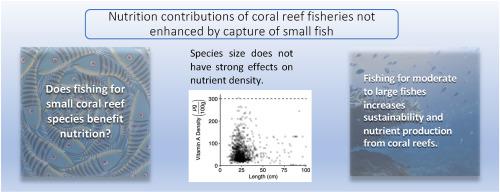Ocean & Coastal Management ( IF 4.6 ) Pub Date : 2024-01-04 , DOI: 10.1016/j.ocecoaman.2023.107011 Bryan P. Galligan , Timothy R. McClanahan

|
Recent policy recommendations have highlighted the nutritional benefits of fisheries that capture small finfish species. Small fish, particularly those that feed in the pelagic zone, tend to be more nutrient dense than larger species, with increased concentrations of calcium, zinc, and omega-3 fatty acids. However, capturing fish below some recommended size limit (i.e., length at first maturity = Lmat) in coral reefs is frequently considered to be unsustainable and associated with reduced yields and losses of ecosystem functions. To evaluate the potential effects of fish body size, we analyzed nutrient concentrations of 424 demersal and pelagic finfish species reported from Western Indian Ocean artisanal fisheries. We found that length and food source are associated with only small differences in nutrient density in the artisanal catches of this region (≤7% of a child's daily requirement in most cases). We also analyzed 20 years of catch monitoring data from Kenya, where many of the common species have Lmat ∼20–25 cm, to test the potential benefits and tradeoffs of capturing small fishes. Small capture sizes were associated with low yields and sexually immature catches with a mean length of 15 cm resulting in 38% lower catch per unit effort, 37% lower nutrient yield, and a 22% lower maturity index compared to a mean body length of 30 cm. Catches of undersized fish were not associated with substantial increases or decreases in nutrient content relative to human nutritional requirements. Thus, coral reef artisanal fisheries should target moderate to large fishes (>20 cm) to maximize overall yield, nutrient yield, and sustainability.
中文翻译:

小鱼捕捞并未增强珊瑚礁渔业的营养贡献
最近的政策建议强调了捕捞小型鱼类的渔业的营养益处。小鱼,特别是那些在远洋区域捕食的鱼,往往比大型鱼类营养更丰富,钙、锌和 omega-3 脂肪酸的浓度更高。然而,在珊瑚礁中捕获低于推荐尺寸限制(即首次成熟长度 = L mat )的鱼类通常被认为是不可持续的,并且与产量减少和生态系统功能丧失有关。为了评估鱼体尺寸的潜在影响,我们分析了西印度洋手工渔业报告的 424 种底层和中上层鱼类的营养浓度。我们发现,长度和食物来源与该地区手工捕获的营养密度的微小差异相关(大多数情况下≤儿童每日需要量的 7%)。我们还分析了肯尼亚 20 年的渔获量监测数据,其中许多常见物种的长度约为20-25 厘米,以测试捕获小鱼的潜在效益和权衡。与平均体长 30 厘米相比,小捕获尺寸与低产量和性成熟捕获量相关,平均长度为 15 厘米,导致每单位努力的捕获量降低 38%,养分产量降低 37%,成熟度指数降低 22%厘米。相对于人类营养需求而言,较小鱼类的捕获量与营养成分的大幅增加或减少无关。因此,珊瑚礁手工渔业应以中型至大型鱼类(>20 厘米)为目标,以最大限度地提高总体产量、营养物产量和可持续性。



























 京公网安备 11010802027423号
京公网安备 11010802027423号